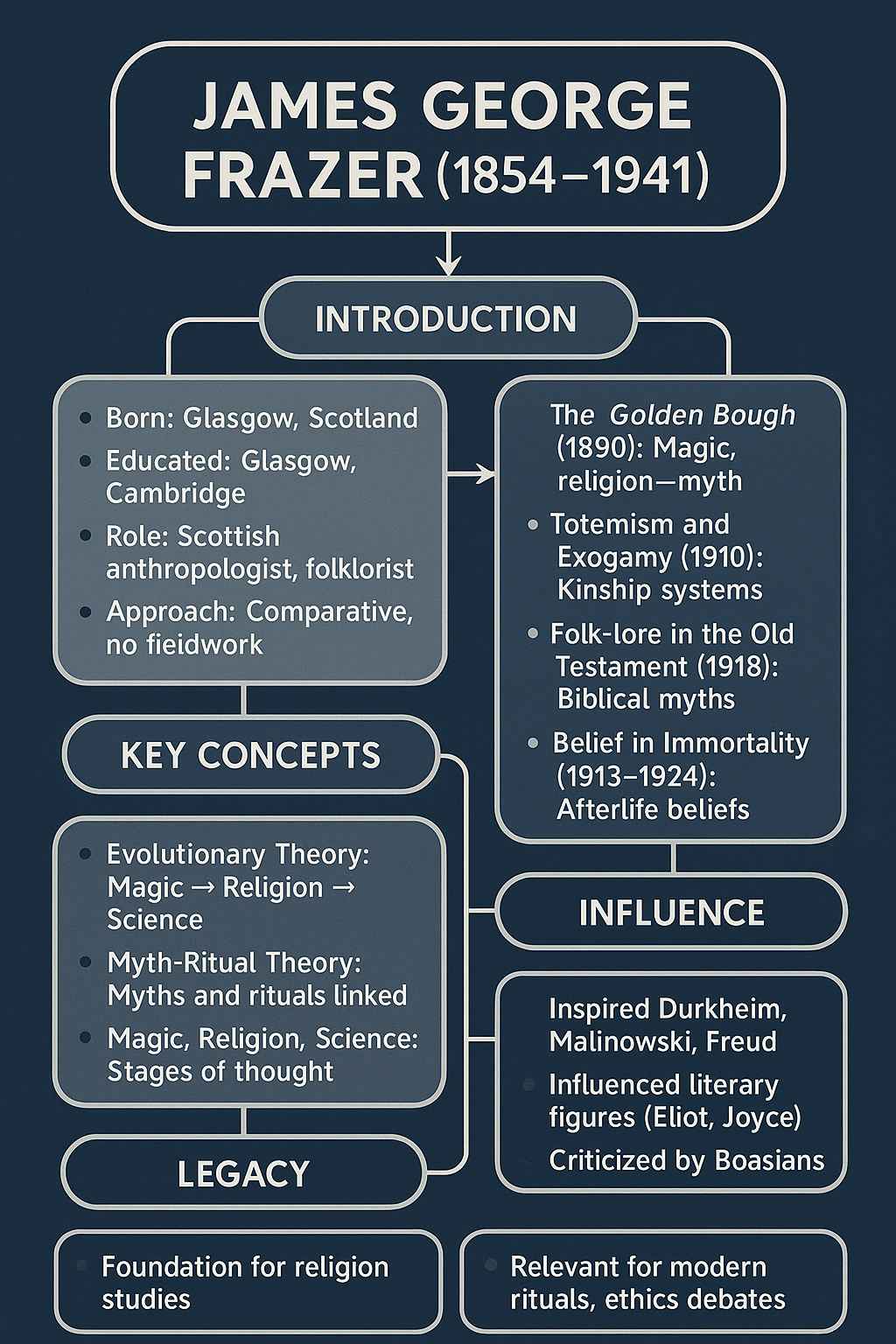Home » Social Thinkers » James George Frazer
James George Frazer
Table of Contents

Introduction to James George Frazer
James George Frazer (1854–1941) was a Scottish anthropologist and folklorist whose groundbreaking work profoundly influenced the development of sociology and anthropology. Born on January 1, 1854, in Glasgow, Scotland, Frazer grew up in a devout Presbyterian family, which shaped his early interest in religion and mythology. He attended the University of Glasgow and later Trinity College, Cambridge, where he earned a classics degree in 1878 and became a Fellow in 1879. Although he never conducted extensive fieldwork, Frazer’s scholarly career was marked by his meticulous synthesis of ethnographic data, mythology, and comparative religion, drawing from a vast array of global sources. His appointment as a Fellow at Cambridge allowed him to dedicate his life to research, producing works that bridged folklore, anthropology, and sociology. Frazer’s intellectual legacy, particularly through his evolutionary perspective on human culture, offers valuable insights for sociology students exploring the interplay of belief systems, social structures, and historical development.
Major Works and Contributions
Frazer’s most celebrated work, The Golden Bough: A Study in Magic and Religion (1890, expanded 1900–1915), is a monumental 12-volume exploration of mythology, religion, and ritual across cultures. Initially inspired by the Roman priest of Nemi, this work traced the evolution of human thought from magic to religion to science, using comparative methods to analyze rituals like the scapegoat and the dying god. The abridged 1922 edition made his ideas accessible to a broader audience, cementing his influence. Totemism and Exogamy (1910), a four-volume study, examined the kinship systems and totemistic practices of Indigenous peoples, linking them to social organization and marriage rules. This work built on earlier theories by John Ferguson McLennan and provided a comparative framework for understanding social bonds.
Psyche’s Task (1909) and Folk-lore in the Old Testament (1918) further explored the psychological and historical dimensions of folklore, arguing that biblical narratives shared roots with ancient myths. The Belief in Immortality and the Worship of the Dead (1913–1924), a three-volume series, investigated aerlife beliefs across cultures, connecting them to social cohesion. Frazer’s The Worship of Nature (1926) analyzed nature worship as a precursor to organized religion, while his later work, Creation and Evolution in Primitive Cosmogonies (1935), synthesized creation myths with evolutionary ideas. These texts collectively showcase Frazer’s commitment to understanding human culture through its symbolic and ritualistic expressions, offering sociology students a rich resource for studying cultural evolution and social institutions.
Key Sociological Concepts
The Evolutionary Theory of Religion
Frazer proposed an evolutionary framework for religion, suggesting that human societies progressed through three stages: magic, religion, and science. In the magical stage, early humans relied on sympathetic and imitative magic to control nature, reflecting a belief in personal efficacy. This evolved into religion, where supernatural beings (gods) were invoked to influence the world, indicating a shi to dependence on divine will. Finally, science emerged as a rational method to understand and manipulate nature, superseding both magic and religion. This unilinear model, detailed in The Golden Bough, aimed to explain the development of human thought and social organization. For sociology students, this theory provides a historical lens to analyze how belief systems shape and are shaped by societal structures, though it has been critiqued for oversimplifying cultural diversity.
The Golden Bough and Myth-Ritual Theory
At the heart of The Golden Bough is the myth-ritual theory, which posits that myths and rituals are interconnected, with rituals oen enacting mythic narratives to ensure social and natural order. Frazer’s analysis of the priest-king of Nemi, who was both a sacred figure and a sacrificial victim, illustrated how rituals reinforced social hierarchy and renewal. He argued that dying-and-reviving god myths (e.g., Osiris, Adonis) reflected agricultural cycles and communal survival strategies. This theory links mythology to social functions, suggesting that rituals maintain group solidarity and authority. Sociology students can use this to explore how collective rituals sustain social cohesion, though Frazer’s universalist approach has been challenged for neglecting local variations.
Magic, Religion, and Science
Frazer’s distinction between magic, religion, and science offers a typology of human thought. He classified magic into homeopathic (imitative) and contagious forms, both based on erroneous causal assumptions, yet serving as early attempts at control. Religion, by contrast, involved propitiation of deities, reflecting humility and dependence, while science relied on empirical observation. This progression, outlined in The Golden Bough, suggests that each stage addressed human needs—control, meaning, and knowledge—shaping social institutions like priesthood and education. For sociology students, this framework illuminates the evolution of authority and knowledge systems, though critics argue it imposes a Western bias on non-Western cultures.
Influence on Sociology and Anthropology
Frazer’s work significantly shaped early anthropology and sociology by introducing comparative methods and evolutionary perspectives. His influence on Émile Durkheim is evident in The Elementary Forms of Religious Life (1912), where Durkheim adapted Frazer’s ritual data to argue that religion reflects social solidarity. Bronisław Malinowski drew on Frazer’s functionalist insights to study magic in the Trobriand Islands, linking it to practical needs. Sigmund Freud’s Totem and Taboo (1913) engaged with Frazer’s totemism theories, exploring the psychological roots of social taboos. These interactions highlight Frazer’s role in interdisciplinary dialogue, influencing sociological theories of religion, ritual, and social control.
His emphasis on cross-cultural comparison inspired the structuralist approaches of Claude Lévi-Strauss, who critiqued but built upon Frazer’s myth analyses. However, Frazer’s armchair anthropology—relying on secondary sources rather than fieldwork—drew criticism from Boasian anthropologists like Alfred Kroeber, who favored empirical data. Despite this, his methodological innovation in synthesizing vast data sets offered a model for sociological research, encouraging the study of global cultural patterns. His work also influenced literary figures like T.S. Eliot and James Joyce, who incorporated his mythic themes into modern literature, indirectly enriching sociological studies of culture.
Legacy and Contemporary Relevance
Frazer’s legacy is both celebrated and contested. The Golden Bough remains a classic, inspiring studies in comparative religion and mythology, and its abridged version continues to be read for its literary and intellectual depth. His evolutionary theory influenced early social theory, providing a foundation for functionalism and structuralism, though it was later overshadowed by cultural relativism. Critics, including Edward Evans-Pritchard, argued that Frazer’s evolutionism and lack of fieldwork undermined his authority, labeling his work speculative. The colonial undertones of his portrayal of “primitive” societies have also sparked ethical debates, aligning with postcolonial critiques of anthropology.
For sociology students, Frazer’s ideas remain relevant in analyzing the role of religion and ritual in modern societies, such as in New Age movements or nationalist ceremonies. His myth-ritual theory applies to understanding contemporary media narratives and collective identity formation. The magic-religion-science progression offers a framework for studying secularization and the rise of scientific rationality. Moreover, the controversy surrounding his methods prompts critical reflection on ethnographic ethics and the power dynamics of knowledge production, a key concern in today’s sociology. His personal life, including his marriage to Lilly Grove and their literary collaborations, adds a human dimension to his scholarly persona
References
- Frazer, J. G. (1890). The Golden Bough: A Study in Magic and Religion. Macmillan (expanded 1900–1915).
- Frazer, J. G. (1910). Totemism and Exogamy. Macmillan.
- Frazer, J. G. (1918). Folk-lore in the Old Testament. Macmillan
|
|

 |
© 2025 sociologyguide |
 |













